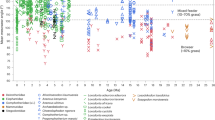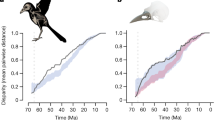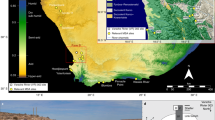Abstract
The fossil record richly illustrates the origin of morphological adaptation through time. However, our understanding of the selective forces responsible in a given case, and the role of behaviour in the process, is hindered by assumptions of synchrony between environmental change, behavioural innovation and morphological response. Here I show, from independent proxy data through a 20-million-year sequence of fossil proboscideans in East Africa, that changes in environment, diet and morphology are often significantly offset chronologically, allowing dissection of the roles of behaviour and different selective drivers. These findings point the way to hypothesis-driven testing of the interplay between habitat change, behaviour and morphological adaptation with the use of independent proxies in the fossil record1.
This is a preview of subscription content, access via your institution
Access options
Subscribe to this journal
Receive 51 print issues and online access
$199.00 per year
only $3.90 per issue
Buy this article
- Purchase on Springer Link
- Instant access to full article PDF
Prices may be subject to local taxes which are calculated during checkout




Similar content being viewed by others
Change history
14 August 2013
A minor typo in the Fig. 4 legend was corrected.
References
Lister, A. M. Behavioural leads in evolution – evidence from the fossil record. Biol. J. Linn. Soc (in the press)
Maglio, V. J. Origin and evolution of the Elephantidae. Trans. Am. Phil. Soc. 63, 1–149 (1973)
Uno, K. T. et al. Late Miocene to Pliocene carbon isotope record of differential diet change among East African herbivores. Proc. Natl Acad. Sci. USA 108, 6509–6514 (2011)
Cerling, T. E. et al. Woody cover and hominin environments in the past 6 million years. Nature 476, 51–56 (2011)
Levin, N. E., Brown, F. H., Behrensmeyer, A. K., Bobe, R. & Cerling, T. E. Paleosol carbonates from the Omo Group: isotopic records of local and regional environmental change in East Africa. Palaeogeogr. Palaeoclimatol. Palaeoecol. 307, 75–89 (2011)
Sanders, W. J., Gheerbrant, E., Harris, J. M., Saegusa, H. & Delmer, C. in Cenozoic Mammals of Africa. (eds Werdelin, L. & Sanders, W. J. ) 161–251 (Univ. of California Press, 2010)
Kingston, J. D. in Paleontology and Geology of Laetoli: Human Evolution in Context. Volume 1: Geology, Geochronology, Paleoecology and Paleoenvironment (ed. T. Harrison) Ch. 15 293–328 (Springer, 2011)
Cerling, T. E., Harris, J. M. & Leakey, M. G. Browsing and grazing in elephants: the isotope record of modern and fossil proboscideans. Oecologia 120, 364–374 (1999)
Cerling, T. E. et al. Global change through the Miocene/Pliocene boundary. Nature 389, 153–158 (1997)
Zazzo, A. et al. Herbivore paleodiet and paleoenvironmental changes in Chad during the Pliocene using stable isotope ratios of tooth enamel carbonate. Paleobiology 26, 294–309 (2000)
Hummel, J. et al. Another one bites the dust: faecal silica levels in large herbivores correlate with high-crowned teeth. Proc. R. Soc. Lond. B 278, 1742–1747 (2011)
Mendoza, M. & Palmqvist, P. Hypsodonty increase in ungulates: an adaptation for grass consumption or for foraging in open habitat? J. Zool. 274, 134–142 (2008)
Janis, C. M. in The Ecology of Browsing and Grazing (eds Gordon, I. J. & Prins, H. H. T. ) 21–45 (Springer, 2008)
Damuth, J. & Janis, C. M. On the relationship between hypsodonty and feeding ecology in ungulate mammals, and its utility in palaeoecology. Biol. Rev. Camb. Philos. Soc. 86, 733–758 (2011)
Strömberg, C. A. E. Evolution of hypsodonty in equids: testing a hypothesis of adaptation. Paleobiology 32, 236–258 (2006)
Mihlbachler, M. C., Rivals, F., Solounias, N. & Semprebon, G. M. Dietary change and evolution of horses in North America. Science 331, 1178–1181 (2011)
Lucas, P. W. et al. Mechanisms and causes of wear in tooth enamel: implications for hominin diets. J. R. Soc. Interface 10, 20120923 (2013)
Strömberg, C. A. E. Evolution of grasses and grassland ecosystems. Annu. Rev. Earth Planet. Sci. 39, 517–544 (2011)
Feakins, S. J. & DeMenocal, P. B. in Cenozoic Mammals of Africa (eds Werdelin, L. & Sanders, W. J. ) 45–55 (Univ. of California Press, 2010)
Valentin, C. in Global Change and Terrestrial Ecosystems (eds Walker, B. H. & Steffen, W. ) 317–338 (Cambridge Univ. Press, 1996)
Bealey, W. J. et al. Estimating the reduction of urban PM10 concentrations by trees within an environmental information system for planners. J. Envtl. Mgmt. 85, 44–58 (2007)
Codron, D. et al. Functional differentiation of African grazing ruminants: an example of specialized adaptations to very small changes in diet. Biol. J. Linn. Soc. 94, 755–764 (2008)
Sanders, W. J. & Haile-Selassie, Y. A new assemblage of Mid-Pliocene proboscideans from the Woranso-Mille Area, Afar Region, Ethiopia: taxonomic, evolutionary, and paleoecological considerations. J. Mamm. Evol. 19, 105–128 (2012)
Lister, A. M. et al. New fossil remains of Elephas from the southern Levant: implications for the evolutionary history of the Asian elephant. Palaeogeogr. Palaeoclimatol. Palaeoecol.. http://dx.doi.org/10.1016/j.palaeo.2013.05.013 (20 May 2013)
Lister, A. M. & Sher, A. V. Gradual evolution and speciation in the origin of the woolly mammoth. Science 294, 1094–1097 (2001)
Strömberg, C. A. E. The origin and spread of grass-dominated ecosystems in the Late Tertiary of North America: preliminary results concerning the evolution of hypsodonty. Palaeogeogr. Palaeoclimatol. Palaeoecol. 177, 59–75 (2002)
Hautier, L. et al. New material of Anancus kenyensis (Proboscidea, Mammalia) from Toros-Menalla (Late Miocene, Chad): contribution to the systematics of African anancines. J. Afr. Earth Sci. 53, 171–176 (2009)
Sanders, W. J. in Paleontology and Geology of Laetoli: Human Evolution in Context. Volume 2: Fossil Hominins and the Associated Fauna (ed. Harrison, T. ) 233–262 (Springer, 2011)
Rohland, N. et al. Proboscidean mitogenomics: chronology and mode of elephant evolution using mastodon as outgroup. PLoS Biol. 5, e207 (2007)
Eggert, L. S., Rasner, C. A. & Woodruff, D. S. The evolution and phylogeography of the African elephant inferred from mitochondrial DNA sequence and nuclear microsatellite markers. Proc. R. Soc. Lond. B 269, 1993–2006 (2002)
Levin, N. E. Compilation of East Africa soil carbonate stable isotope data. Integrated Earth Data Applications http://dx.doi.org/10.1594/IEDA/100231 (2013)
Sikes, N. E. & Ashley, G. M. Stable isotopes of pedogenic carbonates as indicators of paleoecology in the Plio-Pleistocene (upper Bed I), western margin of the Olduvai Basin, Tanzania. J. Hum. Evol. 53, 574–594 (2007)
Quinn, R. L., Lepre, C. J., Wright, J. D. & Feibel, C. S. Paleogeographic variations of pedogenic carbonate δ13C values from Koobi Fora, Kenya: implications for floral compositions of Plio-Pleistocene hominin environments. J. Hum. Evol. 53, 560–573 (2007)
Levin, N. E., Quade, J., Simpson, S. W., Semaw, S. & Rogers, M. Isotopic evidence for Plio-Pleistocene environmental change at Gona, Ethiopia. Earth Planet. Sci. Lett. 219, 93–110 (2004)
Bestland, E. A. & Krull, E. S. Palaeoenvironments of Early Miocene Kisingiri volcano Proconsul sites: evidence from carbon isotopes, palaeosols and hydromagmatic deposits. J. Geol. Soc. Lond. 156, 965–976 (1999)
Kingston, J. D., Marino, B. D. & Hill, A. Isotopic evidence for Neogene hominid paleoenvironments in the Kenya Rift Valley. Science 264, 955–959 (1994)
Cerling, T. E. et al. Expansion and emergence of C4 plants. Nature 371, 112–113 (1994)
Ségalen, L., Lee-Thorp, J. A. & Cerling, T. Timing of C4 grass expansion across sub-Saharan Africa. J. Hum. Evol. 53, 549–559 (2007)
Cerling, T., Harris, J. & Leakey, M. in Lothagam: The Dawn of Humanity in Eastern Africa Vol. 1 (eds Leakey, M. G. & Harris, J. M. ) 605–624 (Columbia Univ. Press, 2003)
Bobe, R. The evolution of arid ecosystems in eastern Africa. J. Arid Environ. 66, 564–584 (2006)
MacInnes, D. G. Miocene and post-Miocene Proboscidea from East Africa. Trans. Zool. Soc. Lond. 25, 33–106 (1942)
Tassy, P. Présence du genre Choerolophodon Schlesinger (Proboscidea, Mammalia) dans le Miocène est-africain. C. r. hebd. Séanc. Acad. Sci. Paris 284, 2487–2490 (1977)
Pickford, M. Afrochoerodon nov. gen. kisumuensis (MacInnes) (Proboscidea, Mammalia) from Cheparawa, Middle Miocene, Kenya. Ann. Paleontol. 87, 99–117 (2001)
Tassy, P. Nouveaux Elephantoidea (Mammalia) dans le Miocène du Kenya. Cahiers de Paléontologie (CNRS, Paris, 1986)
Kunimatsu, Y. et al. A new Late Miocene great ape from Kenya and its implications for the origins of African great apes and humans. Proc. Natl Acad. Sci. USA 104, 19220–19225 (2007)
Tassy, P. in Lothagam: The Dawn of Humanity in Eastern Africa (eds Leakey, M. G. & Harris, J. M. ) 331–358 (Columbia Univ. Press, 2003)
Tsujikawa, H. The palaeoenvironment of Samburupithecus kiptalami based on its associated fauna. Afr. Study Monogr. 32 (Suppl.). 51–62 (2005)
Lister, A. M., Sher, A. V., van Essen, H. & Wei, G. The pattern and process of mammoth evolution in Eurasia. Quat. Int. 126–128, 49–64 (2005)
Inuzuka, N. & Takahashi, K. Discrimination between the genera Palaeoloxodon and Elephas and the independent taxonomical position of Palaeoloxodon (Mammalia: Proboscidea). Miscelánea en homenaje a Emiliano Aguirre 2, 234–244 (2004)
Shoshani, J. et al. Relationships within the Elephantinae using hyoid characters. Quat. Int. 169–170, 174–185 (2007)
Saegusa, H. & Gilbert, W. H. in Homo erectus in Africa, Pleistocene Evidence from the Middle Awash (eds Henry, W., Gilbert, W. H. & Asfaw, B. ) 193–226 (Univ. of California Press, 2008)
Beden, M. Les Elephants (Loxodonta et Elephas) d’Afrique Orientale. Systématique, phylogénie, intérêt biochronologique. PhD thesis, Univ. Poitiers. (1979)
Beden, M. Elephas recki Dietrich, 1915 (Proboscidea, Elephantidae). Évolution au cours du Plio-Pléistocène en Afrique orientale. Geobios 13, 891–901 (1980)
Todd, N. E. Reanalysis of African Elephas recki: implications for time, space and taxonomy. Quat. Int. 126–128, 65–72 (2005)
Ferretti, M. P., Ficcarelli, G., Libsekal, Y., Tecle, T. M. & Rook, L. Fossil elephants from Buia (Northern Afar Depression, Eritrea) with remarks on the systematics of Elephas recki (Proboscidea, Elephantidae). J. Vertebr. Paleontol. 23, 244–257 (2003)
Sanders, W. J. & Haile-Selassie, Y. A new assemblage of Mid-Pliocene proboscideans from the Woranso-Mille Area, Afar Region, Ethiopia: taxonomic, evolutionary, and paleoecological considerations. J. Mamm. Evol. 19, 105–128 (2012)
Beden, M. in Koobi Fora Research Project, Vol. 2 (ed. Harris, J. M. ) 40–129 (Clarendon Press, 1983)
Behrensmeyer, A. K. et al. The Pleistocene locality of Kanjera, Western Kenya: stratigraphy, chronology and paleoenvironments. J. Hum. Evol. 29, 247–274 (1995)
Kalb, J. E. & Mebrate, A. Fossil elephantoids from the hominid-bearing Awash group, Middle Awash Valley, Afar Depression, Ethiopia. Trans. Am. Phil. Soc. 83, 1–114 (1993)
Tassy, P. in Geology and Palaeobiology of the Albertine Rift Valley, Uganda-Zaire, Vol. II (eds Senut, B. & Pickford, M. ) 217–257 (CIFEG, 1994)
Tiercelin, J.-J., Michaux, J. & Bandet, Y. Le Miocène supérieur du Sud de la dépression de l'Afar, Ethiopie: sédiments, faunes, âges isotopiques. Bull. Soc. Geol. Fr. 21, 255–258 (1979)
Geraads, D., Alemseged, Z. & Bellon, H. The late Miocene mammalian fauna of Chorora, Awash basin, Ethiopia: systematics, biochronology and 40K-40Ar age of associated volcanics. Tertiary Res. 21, 113–122 (2002)
International Union for the Conservation of Nature. The IUCN Red List of Threatened Species. http://www.iucnredlist.org/details/12392/0 (accessed 06 April 2013) (2012)
Roca, A. L., Georgiadis, N., Pecon-Slattery, J. & O’Brien, S. J. Genetic evidence for two species of elephant in Africa. Science 293, 1473–1477 (2001)
Debruyne, R. Différenciation Morphologique et Moléculaire des Elephantinae (Mammalia, Proboscidea). PhD thesis, Muséum National d’Histoire Naturelle, Paris. (2003)
Morrison-Scott, T. C. P. A revision of our knowledge of African elephants’ teeth, with notes on forest and “pygmy” elephants. Proc. Zool. Soc. Lond. 117, 505–527 (1947)
Laws, R. M. Age criteria for the African elephant, Loxodonta a. africana. East African Wildlife Journal 4, 1–37 (1966)
Aguirre, E. E. Revisión sistemática de los Elephantidae por su morfología y morfometría dentaria. Estudios Geologicos 24, 109–167; 25, 123–177,. 317–367 (1969)
Grubb, P., Groves, C. P., Dudley, J. P. & Shoshani, J. Living African elephants belong to two species: Loxodonta africana (Blumenbach, 1797) and Loxodonta cyclotis (Matschie, 1900). Elephant 2, 1–4 (2000)
Deino, A. L. in Paleontology and Geology of Laetoli: Human Evolution in Context. Volume 1: Geology, Geochronology, Paleoecology and Paleoenvironment (ed. T. Harrison) 77–98 (Springer, 2011)
Acknowledgements
I thank T. E. Cerling, W. J. Sanders and C. M. Janis for discussion; K. Uno, Y. Kunimatsu and H. Nakaya for assistance with specimen identification; and P. Hadland, R. Portela-Miguez and W. Wendelin for access to collections.
Author information
Authors and Affiliations
Corresponding author
Ethics declarations
Competing interests
The author declares no competing financial interests.
Supplementary information
Supplementary Information
This file contains Supplementary Figures 1-2 and full legends for Supplementary Tables 1-3. (PDF 416 kb)
Supplementary Data
This file contains Supplementary Tables 1-3, see Supplementary Information document for full legends. (XLSX 103 kb)
Rights and permissions
About this article
Cite this article
Lister, A. The role of behaviour in adaptive morphological evolution of African proboscideans. Nature 500, 331–334 (2013). https://doi.org/10.1038/nature12275
Received:
Accepted:
Published:
Issue Date:
DOI: https://doi.org/10.1038/nature12275
This article is cited by
-
Fluctuating climate and dietary innovation drove ratcheted evolution of proboscidean dental traits
Nature Ecology & Evolution (2023)
-
The rise and fall of proboscidean ecological diversity
Nature Ecology & Evolution (2021)
-
Late Middle Pleistocene Elephants from Natodomeri, Kenya and the Disappearance of Elephas (Proboscidea, Mammalia) in Africa
Journal of Mammalian Evolution (2020)
-
Brain evolution in Proboscidea (Mammalia, Afrotheria) across the Cenozoic
Scientific Reports (2019)
-
Running Over the Same Old Ground: Stegomastodon Never Roamed South America
Journal of Mammalian Evolution (2019)
Comments
By submitting a comment you agree to abide by our Terms and Community Guidelines. If you find something abusive or that does not comply with our terms or guidelines please flag it as inappropriate.



